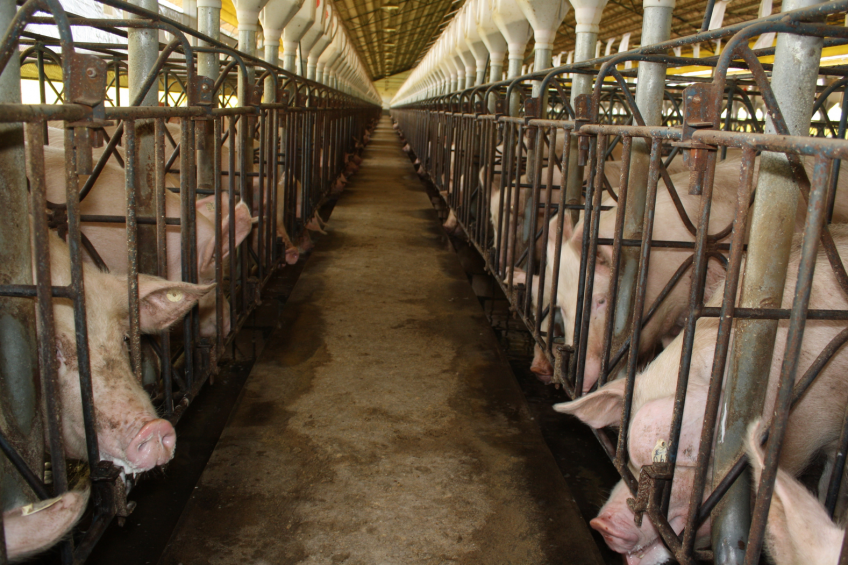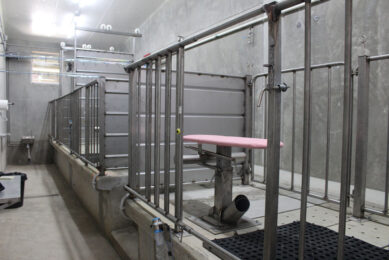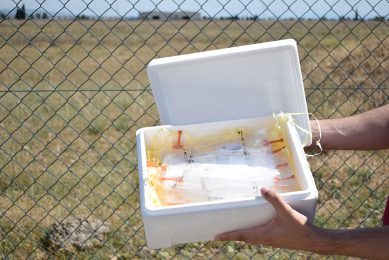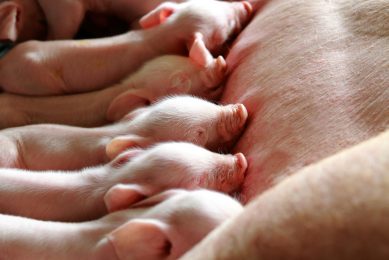Sow stalls – a brief history

There was a time when pigs and sows were held in fenced pastures or outdoor pens. With the growing demand for pork, the industry professionalised too. When did the concept of sow stalls develop and what were their purpose?
By Prof John J. McGlone, Texas Tech University, Lubbock, TX, United States
They call it by many names – the crate, the stall, the box, a pen, a case, individual accommodation, and in the ultimate statement of political correctness and consumer cuddling – the individual maternity pen. The crate or stall (most common used terms) is probably the most common system for keeping pregnant sows in the world. True, the crate is banned in Europe and some US states, but it is still used in the majority of industrialised pig farming production units from Brazil to North America to Asia.
Modern pork production has three phases for the adult sow. Sows are in breeding, gestation and farrowing phases. The crate may be used in all, some or none of these phases. Most bans of the crate are during ‘gestation’ which typically means from breeding confirmation until the end of gestation. Breeding confirmation is typically from breeding until 28 to 35 days after service.
The question today is: What is it, when did it develop, and why was the crate used in the first place?
What is a ‘crate’?
The crate is a structure that contains a sow. Most typically, it prevents the sow from turning around. The crate or stall requires that the sow faces forward, towards a feeder and watering device. And her manure will be deposited in a smaller location as her rear end is fairly limited in its range of motion as well.
The two most common names for this keeping system are crates and stalls. Either term can be correct, depending on its use. A stall, though, implies that the rear of the structure is open as in a parking stall in a parking lot or garage. A crate sounds like something you ship equipment in – all solid sided. In their extremes, this sow structure is neither a crate nor a stall. Hence we see the term interchanged in writings. I prefer the term crate simply because it is less incorrect, technically.
We see many styles of crates or stalls. The fronts may be slanted back, as can be seen in the main image or be perpendicular with the floor (straight up). Then, the side walls can be a full rectangle or they can have a cut-out slot to allow ease of artificial insemination. The ‘AI’ side and back fencing is the most common today on newer farms.
Crates measure from 0.5 to 0.7 m (20 to 28 inches) wide and from 2 to 2.5 m long (6.5 to 8 feet). The floor is typically concrete with a solid area on the front part of the sow area and a slatted floor in the rear. Or, the entire floor is slatted. The feeder is either recessed in the floor or above the floor. While sows may benefit from bedding (such as straw), the typical crate does not contain bedding. Thus, when sows move to group housing, they may (or may not) also gain access to bedding and a solid rather than slatted floor.
When did the crate develop?
The farrowing crate was developed before the breeding/ gestation crate in the US. By the late 1960s the farrowing crate was very common in the US and Europe. The gestation crate was common in new buildings in the 1980s.
From the US perspective, a leader in development of sow keeping systems was a company called Lubbock Swine Breeders (later bought by DeKalb, then Monsanto and now broken up and lost). Lubbock Swine Breeders was started by Euel Liner and his son-in-law Roy Poage. They started a relatively large-scale breeding stock farm in the 1950s with 1,500 sows. This was very large in its day. They started with 300 sows, then moved to 750, then 1,500 sows. They sold purebred and crossbred breeding stock in the US and internationally. They sold the first US genetics to Japan in the 1970s. Today, breeding stock commonly moves between the US, Europe, Latin America and Asia.
Along with advanced swine genetics (for the day), Lubbock Swine Breeders realised that to support sales, they needed to develop breeding, gestation and farrowing systems. So they started a company called Hog Builders to build new farms. The modern farm system was so new, that they gave a tour to reporters. The video tour can be found on our web site and is instructive about how the new concept was presented in 1964.
In 1964, Lubbock Swine Breeders had sows in gestation and farrowing crates. They also experimented with tethers and indoor-outdoor systems. They settled on the crate throughout the life of the adult pig, as did other newer farms from 1970 to the present in the US.
Why did the crate develop popularity?
We searched the US ‘pig press’ for the first stories about gestation crates. One of the first pictures of sows in gestation crates was originally published in 1968, in an issue of Hog Farm Management, a magazine which is no longer published. While gestation crates were an experimental system in the 1950s, they were common amongst newer facilities in the 1970s. As farms remodelled and were built, the crate became more common.
We know that the development in the US was in parallel with systems in Europe. But Europe has a much longer history of pork production than the US. We know from recent work that pigs were domesticated in Cyprus more than 11,400 years ago. The systems were simple at the start and they developed into more complex production systems over time.
Seaton Baxter published a seminal book in 1984 called Intensive Pig Production giving details of intensive pig production. At this same time, Stan Curtis, a renowned faculty member at the University of Illinois (US) was publishing a weekly newspaper called ‘Confinement’. Indeed, industrial pig farming was celebrated as a modern application of advanced technology for the good of the pig and to the economic benefit of both pork producers and consumers.
Baxter reported a system of called ‘pig cases’ from 1807 in the UK. The figure shows an excerpt from Seaton’s book (published by Granda Press, no longer in business) that shows the ‘pig cases’. Seaton reports that Arthur Young wrote about Mr Pattison’s pig cases: “…each to contain a pig, and to fit him as near as may be when he is in, he cannot attempt to turn himself around…” So the crate is not new.
The crate was a natural evolution of a production system when healthy pigs and a low cost of production were the primary goals. First pigs were hunted (before 11,400 year ago and through to today) and eaten. Then, people discovered that if they just threw food scraps outside the fence, the pigs would come eat it. In medieval times, a person might blow a trumpet to call the pigs and then throw the food beyond the wall of the city. Pigs had a Pavlovian response to the horn and learned to come running.
Then, people planted trees that provided food for pigs when the fruits or acorns dropped. Then, they placed the pigs in fenced pastures. Then, they were kept in outdoor pens. Then largely to solve parasite problems, pigs were put in indoor-outdoor systems. Then just indoors in groups. Then, individual crates were developed. The idea of a crate is not new, but its specifications have been refined in the past few decades to be an efficient system. The main reason sows are kept in gestation crates is economics.
The cost of production is lower because the housing space per sow is less for the crate than for group housing. Crates occupy 1.3 m2 while grouped sows require more than 1.8 m2 per sow. If sow housing (building and penning material) is 7% of the cost of production of a finished pig, then to increase floor space is 38% higher or about 2.5% of the cost of production of the live pig. While one could argue that the 2.5% is really 1%; it matters not – the push back from conversion is primarily economic. True, sows in groups fight more and it is more difficult to manage feed intake. However, the overall productivity for sows in groups or pens are equal. If laws or markets demand use of group housing, then the producer is obligated to use group housing. If no laws or market requirements are in place, then economics drives the use of the crate. If one considers only cost of production, then the crate is a natural evolution of production systems.
What are the issues with the crate?
The main drivers for meat production are consumer desires. People buy what they want and farmers have produced foods people wanted to eat for millennia. What drove US and European consumers after World War II was cost. Food was in short supply and expensive. So consumers asked researchers and farmers to find ways to lower food costs. And they did. One way to lower the cost of production was to move pigs indoors. Moving indoors was a way to rid the pigs of certain diseases, especially parasites. Modern pig farms have virtually no internal or external parasites. This is a tribute to our technological development of an efficient production system.
When a person builds a building, how much space should animals be given? Each square meter of space costs real money. Since it is a business, naturally people try to determine the minimum space needed to get the job done.
The crate provides a way to provide the least amount of space to the sow. A given building will have the most sows if crates are used. And if her movements are reduced, she should require less feed. If we control the air temperature within her thermal comfort zone, then we can minimise feed intake even further.
But some consumers have issues beyond simply economics. The European Union and some US states have banned the gestation crate based on the majority view of its citizens or its leaders. Consumers and activists object to the gestation crate for two general reasons. Firstly, the crate prevents the sow from turning around – a natural behaviour. Secondly, sows show forms of stereotypical behaviours in the gestation crate. Never mind that sows also show these behaviours in group housing.
Any negative-seeming behaviours shown by crated sows add credence to its critics. The crate is real and it is not going away any time soon. Half the pigs in the world are in China and they have no laws now or in the future to ban the gestation crate. And their industry is growing. They import pork with no restrictions on the housing system deployed. Some Latin American countries (like Brazil) may impose western European rules for pork exported to the EU. However, most Latin American farms exporting to Eastern Europe or Asia or producing for the domestic consumer market have no restrictions.
European countries who hope to export to other non-EU countries are putting themselves at a small economic disadvantage compared with most of the US and Latin America. Market channels are more powerful mechanisms for change. When retail purchasers (restaurants and grocery stores) impose change, then the industry will change.
As pork production professionals, we know how to keep sows in either crates or group pens. The world will dictate if they want change or to keep the status quo. Either way, pork production will grow with the growing population and growing affluence among pork buyers.
Advantages of sow stalls
Lowest building cost
Allows control of individual sow feed intake
Allows individual pig care in an isolated structure
Allows reduced overall feed intake due to less energy needed for social behaviours
Ease of worker interactions, especially during AI
Fewer injuries of sows
Disadvantages of sow stalls
Lack of ability to observe motility and lameness
Stereotyped behaviours observed
Negative consumer view in many markets (EU and USA, but not Asia or Latin America)
Lack of sow’s natural social interactions
Join 18,000+ subscribers
Subscribe to our newsletter to stay updated about all the need-to-know content in the pigsector, three times a week. Beheer
Beheer





 WP Admin
WP Admin  Bewerk bericht
Bewerk bericht